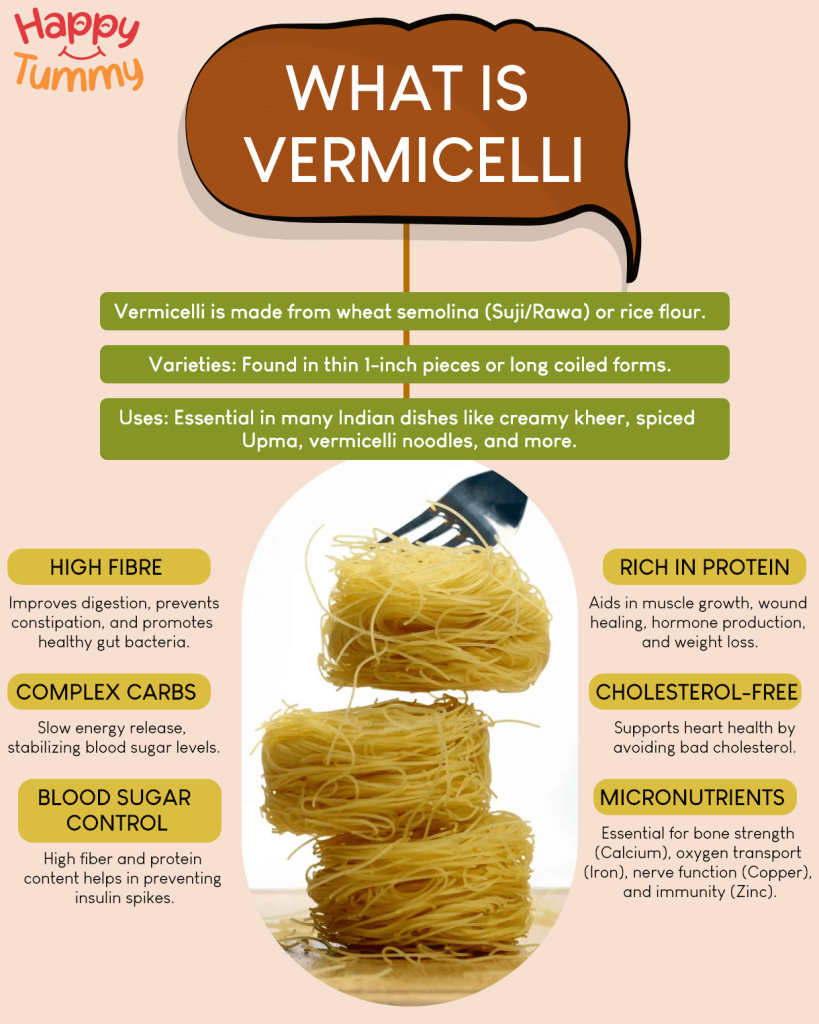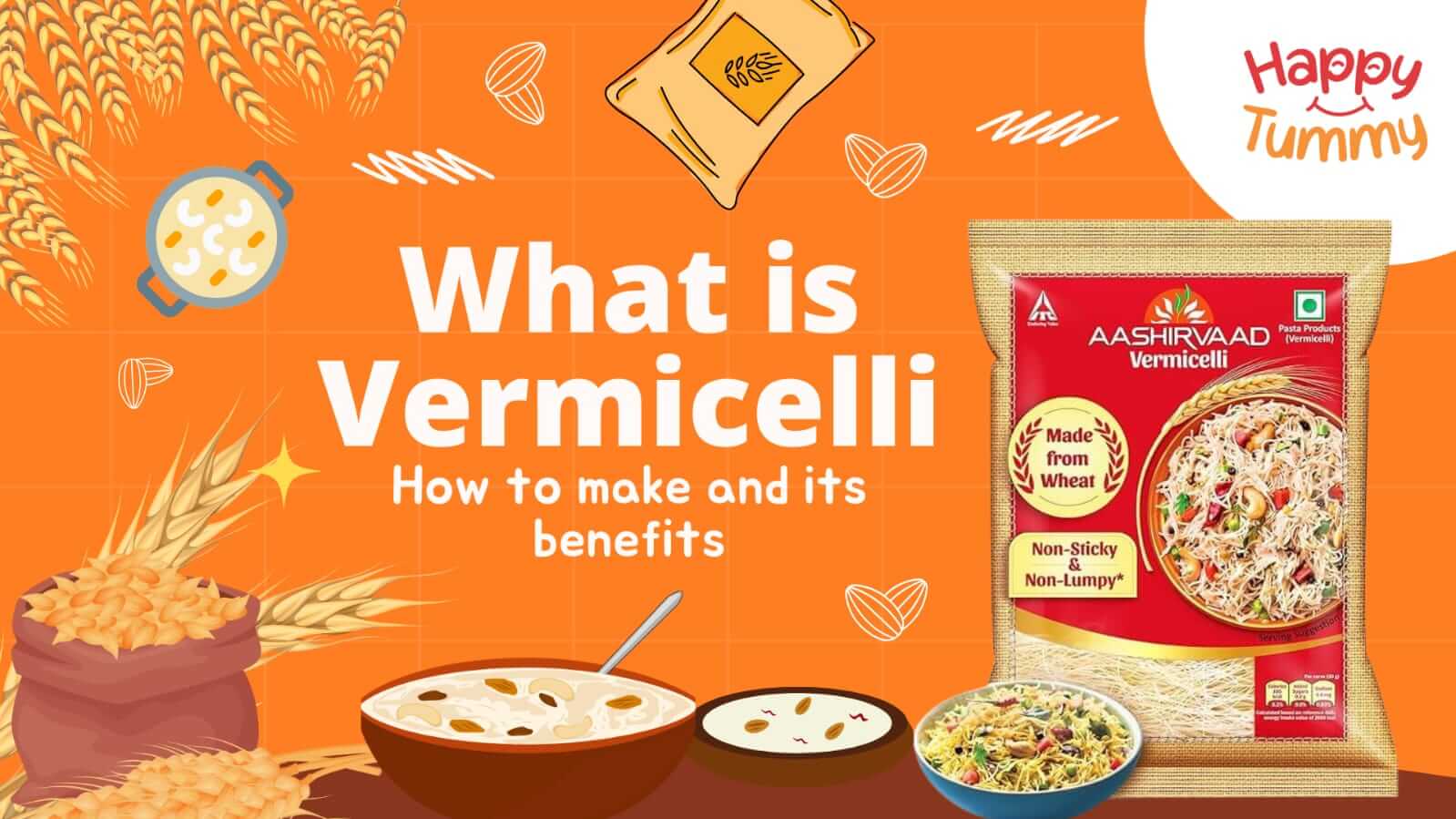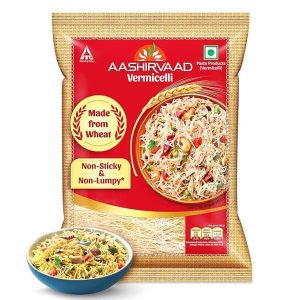Table of Contents
The core Indian dietary tradition always recommends starting the day with a healthy and wholesome breakfast. It sets the tone of our day and provides the much-required initial boost, a fantastic head-start.
But the pace of our lives is much. It often slams us down the path of making unhealthy breakfast choices. However, only if we look around, do we find that there are some super-healthy and convenient breakfast options available in the market. One of those super-nutritious options is vermicelli.
What is vermicelli? What are its benefits? And how is it made? We will answer everything vermicelli here. So, let’s start roasting our healthy dishes.
What Is Vermicelli?
In ancient India, women would sit socially with wheat dough at the centre of their circle. They would then take small dumplings out of it and break them into tiny, thread-like 1-inch pieces using their fingers.
These pieces were then left under the sun to dry. Once done, this dried form was used to make numerous salty or sweet dishes. Today, this same thing is made using modern technology in big companies.
Vermicelli, also known as Seviyan or Semiya in India, is a slender pasta. It looks similar to spaghetti but thinner. You’ll usually find it in two varieties across India:
- Thin 1-inch pieces
- Long coiled form
Today, vermicelli is typically crafted from either
- Wheat semolina (Suji/Rawa) [1]
- Rice flour
However, wheat semolina is commonly used. And its uses? Delicious and numerous. It fuels various Indian recipes, both sweet and savoury. For example:
- Creamy kheer
- Spiced vegetable upma
- Vermicelli noodles
- Vermicelli rice
And the list goes on as far as the creativity goes.
Now, why is vermicelli a healthy addition to your breakfast? Let’s get into it by first understanding its nutrition and then all those vermicelli benefits.
Vermicelli Nutrition
When it comes to commercially made vermicelli, the nutritional value differs from company to company due to the method and ingredients used.
If vermicelli is made using wheat semolina, which is the healthier option over rice, the calories and nutrition will be different.
This table tells you the nutritional values of wheat-based vermicelli.
Vermicelli (Wheat Semolina) – nutritional value – 100 grams [2]
| Energy | 334 kcal |
| Protein | 10 grams |
| Fat | 0.5 grams |
| Carbs | 70 grams |
| Fibre | 9.5 grams |
| Minerals | Calcium, Iron, Copper, Magnesium, Selenium, Zinc, Phosphorous, Potassium, etc. |
| Vitamins and other plant compounds | Vitamin B1, B2, B3, B5, B6, B7 (biotin), B9 (folate), D, Carotene, Lutein + Zeaxanthin, Flavonoids, etc. |
A mere glimpse is enough to vouch for the wheat-based vermicelli. Now, let’s understand all the vermicelli benefits.
Vermicelli Benefits – A Quick and Nutritious Ingredient

The benefits of vermicelli are stated below for wheat vermicelli. If you are consuming rice-based vermicelli, these benefits won’t apply.
1. High In Fibre Aids Digestive Health
Wheat vermicelli is a rich source of fibre. A mere 100 grams of vermicelli provides us with around 10 grams of fibre. But why fibre?
Although our bodies don’t contain specific enzymes to digest fibre, it still serves two vital purposes in our health:
- Fibre adds bulk to the food inside our intestines and thus helps it move smoothly. This prevents constipation.
- Also, fibre acts as a prebiotic, which means that it feeds your good gut bacteria and strengthens their digestive capability. Consequently, our digestion improves, and energy levels pump up.
Today, the benefits of fibre are no longer hidden from us. All hail the power and potential of science. Fibre has been proven to be helpful in [3]
- Improving gut health
- Controlling overall weight and obesity
- Controlling blood sugar
- Helping the heart get healthier and younger
And much more.
2. Rich in Nutrients (Protein, vitamins, minerals, etc.)
Nutrition is not just about getting calories, fat, and protein. It’s much more. And natural foods such as wheat vermicelli get this very well.
Surely, as we saw, vermicelli provides high amounts of protein. You may get anywhere from 10-12 grams of protein from 100 grams of vermicelli. This is crucial, considering the importance of protein in our lives. It helps us in muscle growth, wound healing, hormone production, weight loss, and whatnot. [4]
Apart from being rich in protein, vermicelli also offers complex carbs. Complex carbs are much better than normal carbs. Unlike simple carbs, complex carbs release energy slowly into the bloodstream. This controls unhealthy blood sugar spikes.
In terms of micronutrients, wheat vermicelli is a gem. It offers numerous essential vitamins, minerals, and plant compounds that help our bodies and boost our overall health. Here are some micronutrients present in vermicelli and how they benefit us:
- Calcium: Ever felt that your bones might be falling under your weight? That they are brittle and weak? Calcium is something that helps strengthen bones.
- Iron: Iron prevents anaemia. This means you don’t feel weak and fatigued. It is because iron transports oxygen through the blood to each inch of our bodies.
- Copper: Copper not only improves nerve function but also strengthens immunity. Ignore it, and you might soon find yourself falling apart.
- Magnesium: Magnesium is a gem of a mineral. It takes part in over 300 biochemical reactions. Ignore it and you might feel weak, lacking sleep quality, and overall strength.
- Zinc: If you have a strong memory, you might remember how zinc was being recommended during COVID-19 times to enhance immunity. It helps. And if you don’t remember it well, then consume vermicelli as it contains Vitamin B, Magnesium, etc., which improves brain functioning. [4]
- Vitamin Bs: Vermicelli contains numerous vitamin Bs such as B1, B2, B3, B5, B6, B7, etc. All these vitamins serve numerous purposes. For example, B2 helps in breaking down macronutrients, B3 (Niacin) enhances skin health, B6 helps in metabolism and red cell production, B7 (Biotin) gives you smooth and strong hair, skin, etc.
- Carotene: Carotene sharpens our vision and helps us see this world crystal clear. Not just his, it also enhances immunity.
- Lutein + Zeaxanthin: These antioxidants are great at protecting eyes from harmful light waves. They potentially reduce the risk of age-related macular degeneration.
- Flavonoids: These plant compounds possess strong anti-inflammatory and antioxidant properties. They are great at protecting the heart and providing it with youth.
Great right? But there’s more to add to the many vermicelli benefits.
3. Cholesterol Free
Today, rare are chances of finding any cholesterol-free food in the market. But Vermicelli can provide you with the much-required respite. It contains no cholesterol. However, the problem is not cholesterol but bad cholesterol.
There are two types of cholesterol:
- Good – HDL (High-Density Lipoprotein)
- Bad – LDL (Low-Density Lipoprotein)
Our bodies do need good cholesterol to function well. In fact, they produce it. But the market today is full of products loaded with bad cholesterol. Some examples include deep-fried food, fast food such as burgers, noodles, red meat, baked products, tropical oils, etc. Eating such foods leads to blockage of blood vessels. This is never a good thing.
Vermicelli benefits our bodies by providing them with cholesterol-free nutrition, thereby helping our health.
4. May Benefit Blood Sugar
Blood sugar levels should always be balanced. However, today, the picture is quite in some worrying contrast. A spike in blood sugar invites numerous health issues with obesity being at the top of the list. It stops us from freely enjoying the simple joys of life.
The reason for the recent rise in blood sugar imbalance cases is the prevalence of poor diet culture. We eat deep-fried, sugary snacks, and baked goods, drink sugary beverages, and whatnot.
Vermicelli can do wonderfully well at controlling your blood sugar. Here is why:
- It contains complex carbs that slowly release energy into your bloodstream. This slow release prevents insulin spikes and puts a smile
- Vermicelli contains a high amount of protein. Protein is well known to put a brake on blood sugar spikes [6]
- Its high fibre and zero-cholesterol content improves the release of energy and thus prevents sugar spikes in the blood [7]
The vermicelli benefits are numerous, and there are no reasons to ignore them. So, let’s now learn how to make vermicelli in a way that will make you crave it every morning with a hopeful smile on your face.
How to Make Vermicelli?
Vermicelli is one of the easiest foods to make. You can cook it in anywhere between 15-20 minutes. This makes it a brilliant breakfast addition.
Here are some recipes to add colours to your morning vermicelli:
Vermicelli Upma (Namkeen Sevai)
This recipe takes nothing but gives everything. Here are the ingredients required for this recipe:
- ½ cup Aashirvaad Vermicelli
- 1 tomato, 1 onion, 1 carrot, 1 capsicum, 1/4th cup peas, 1 green chilli, and any other vegetable of choice
- Oil/Ghee for tadka
- Salt, hing, turmeric powder, mustard seeds, masala for taste
- Coriander leaves for garnishing
And here is how to make it:
- Start by roasting your vermicelli on low flame. Keep stirring until you see them turning golden brown. Otherwise, you may also buy roasted vermicelli
- Take a pan, add ghee/oil to it, let it come to a hot temperature
- Add a pinch of hing and a teaspoon of mustard seeds. Let them pop
- Add chopped onion and green chilli to the oil and some salt
- Let the onion come to a golden-brownish hue
- Now, add chopped carrots, capsicum, and peas to it
- Keep stirring until semi-cooked and then add chopped tomatoes
- Add turmeric powder and a teaspoon of masala for added taste
- Let the spices cook for some time until you see the oil separating
- Now, add 2-3 glasses of water and your roasted vermicelli to it
- Cook for 5-10 minutes
Take a spoon and check if the vermicelli is cooked. If done, let the water be boiled away to the consistency you want. If you want it to be soupy, which tastes great, leave some water.
Garnish the finished dish with chopped fresh coriander and serve it steaming hot with curd.
Sweet Vermicelli (Meethi Sevaiya)
Sweetness adds joy to our lives. And it is sometimes good to cherish this much red-marked area of life. Surely, you must consume sweet dishes with caution, but you should not ignore them. Also, we can make them in a healthier way too.
Many people like their sweet vermicelli to be hard. But it tastes great in a soupy consistency. Let’s see how:
Note that this recipe uses milk. If you are lactose intolerant, you may replace this with other types of milk such as coconut milk, almond milk, etc.
Ingredients
- Milk 1 litres
- 80 grams of Aashirvaad Vermicelli
- 2 cardamom pods
- Dry fruits of choice
- Saffron (optional)
- Ghee
- Sugar
Recipe:
- Add ghee to a pan and mix your unroasted vermicelli
- Roast them until golden brown and that tempting aroma
- Now, add milk to a large open pot
- Let the milk come to a boil
- Now, add your roasted golden-brown vermicelli
- Let it cook in milk. Keep stirring in between to avoid it getting stuck on the bottom
- Crush your dry fruits to the consistency you prefer
- Add saffron and crushed dry fruit to your vermicelli
- Let the milk come to a thicker consistency
- Add sugar for taste. Try to keep your sugar low to keep it healthy
There you have it, your delicious sweet vermicelli. It tastes heavenly when cold. So, try it out.
Conclusion
Vermicelli has been consumed throughout India for ages. However, grim ignorance has recently emerged. The fast food and deep-fried culture has not only eliminated healthier dishes but has also invited a streak of diseases.
Vermicelli is super healthy and nutritious, which makes it a great breakfast option. It stays loaded with numerous vitamins such as B6, B7, B9, D, etc., minerals such as potassium, copper, calcium, potassium, etc. and several plant compounds such as carotene, lutein, zeaxanthin, and other antioxidants.
These healthy nutrients present in vermicelli serve us numerous benefits such as weight loss, blood sugar stability, a healthy heart, and whatnot. About its protein and fibre content? Brilliant! Vermicelli provides anywhere around 10 grams of protein and 10 grams of fibre.
So, why not give vermicelli a try? Trust us, you’ll love it, cherish it, and make it a permanent part of your breakfast.
FAQs
Vermicelli is typically made from either rice or wheat flour. The dough is prepared by mixing the flour with water, and then it is kneaded until smooth. The dough is then extruded through a machine to form thin, long strands, which are subsequently dried and packaged. Traditional methods involve rolling the dough by hand and sun-drying the noodles.
No, you do not usually need to wash vermicelli before cooking. For rice vermicelli, you typically soak them in warm water until they soften, while wheat vermicelli can be boiled directly in water.
Vermicelli noodles can be a healthy choice, depending on the type and how they are prepared. Rice vermicelli is low in fat and calories but lacks fibre and protein. Wheat vermicelli has more fibre and protein but also contains gluten. Pairing vermicelli with vegetables, lean proteins, and healthy sauces can make them a nutritious part of your diet.

















